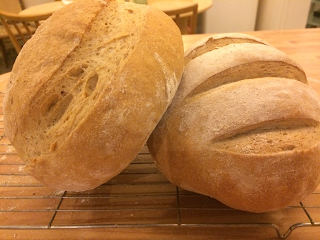 |
| Really good lamination on the Pain au Chocolat |
 |
| Croissants were much easier to shape with lower gluten flour |
 |
| Mr Vitty thinks they need to be bigger.... |
This is my personal musings on what I cook, eat and some of the food science behind the recipes and headlines. You can also follow this blog on facebook at https://www.facebook.com/Vittyfood or twitter @vittydanino
 |
| Really good lamination on the Pain au Chocolat |
 |
| Croissants were much easier to shape with lower gluten flour |
 |
| Mr Vitty thinks they need to be bigger.... |
 |
| Knobbly Quinces |
 |
| Chopped and Ready to Boil |
 |
| Cubed quince cheese |
 |
| Coated with granulated sugar and citric acid |
 |
| In jars ready to take to work |
 |
| Jarrold's Scones - Best in Norwich? |
 |
| Fresh from the oven |
 |
| A cornish treat - clotted cream and jam |
 |
| Caramel Apple Pudding (my invention : ) ) |
 |
| Pain de Campange from Richard Bertinet's 'Dough' |
 |
| Carrot and Coriander Soup |
 |
| Just out of the oven |
 |
| Pudding with its own sauce |
| Ingredients Olive Oil Knob of Butter 2 Medium Onions 8 Carrots Pepper Stock or water Salt Small bunch fresh coriander |
Method Heat the oil and butter over a medium heat. Chop the onion and saute until soft. Peel and roughly chop the carrots and add them to the onions. Stir to coat in the oil/butter. Season with pepper and add enough stock or water to cover the vegetables. Bring to the boil then simmer gently until the carrots are soft. Take the soup off the heat and liquidise or pass through a sieve. Check the seasoning and add more salt and pepper if needed. Keep a couple of sprigs of coriander back for a garnish. Chop the rest of the coriander and stir through the soup. Serve with a sprinkling of coriander over the top. |
| Ingredients Caramel 150 g Caster Sugar 150 g Double Cream 75 g Butter Sponge 2 oz (56 g) Butter 2 oz (56 g) Sugar 1 Egg 1 Medium Bramley Apple 2 oz (56 g) Plain Flour + a little extra 1 teaspoon Baking Powder |
Method Make the caramel. Heat the sugar over a medium heat until it begins to melt. Shake the pan occasionally to ensure the sugar melts evenly. When the sugar has melted boil it until it turns a caramel colour. Remove from the heat and stir in the cream. If the caramel clumps together put the pan back over a medium heat and whisk or stir rapidly until the cream is incorporated and caramel sauce has formed. Take off the heat and stir in the butter. Allow to cool. (This will make far more caramel than you need but the rest can be frozen). Preheat the oven to 180 C. Peel, core and finely grate half the apple and finely dice the other half. Cream together the butter and sugar until light and fluffy. Beat in the egg and the grated apple. The apple will add extra liquid so add a couple of dessert spoons of the extra flour, just enough to absorb the liquid. Sift together the rest of the plain flour with the baking powder and fold into the butter/sugar/apple mixture. Butter 3 metal timbale moulds and place 1 tablespoon of caramel in the bottom. Top with a sprinkling of the diced apple and then divide the apple sponge between the moulds so they are about 3/4 full. Place the moulds in a small roasting tin half filled with water. Place in the preheated oven for about 20 minutes or until a knife or skewer inserted into the sponges comes out clean. Leave for a couple of minutes to settle then run a knife around the pudding and tip into a bowl so that the apple and caramel form a sauce on top of a sticky apple pudding. (If you don't have time to make caramel an almost good pudding can be made by placing diced apple in the bottom of the timbales with about 15 g butter, a heaped dessert spoon of brown sugar and sprinkling of cinnamon. Then top with the sponge mix and proceed as described above) |
 |
| Apple Charlotte |
 |
| Ladies Finger Biscuits - need more practice with a piping bag |
 |
| Everything ready for assembly - Italian Meringue, Whipped Cream, Apple Custard, Caramelised Apple, Ladies Fingers and Calvados Sugar Syrup |
 |
| Ready to Eat |